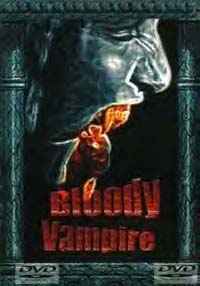 THE
BLOODY VAMPIRE (EL VAMPIRO SANGRIENTO)
(1962, USA Release: 1964)
THE
BLOODY VAMPIRE (EL VAMPIRO SANGRIENTO)
(1962, USA Release: 1964)Director: Michael Morayta
Beverly Wilshire Filmworks/Telefilms International
 THE
BLOODY VAMPIRE (EL VAMPIRO SANGRIENTO)
(1962, USA Release: 1964)
THE
BLOODY VAMPIRE (EL VAMPIRO SANGRIENTO)
(1962, USA Release: 1964)Cast: Carlos Agosti (Count Siegfried von Frankenhausen), Erna Martha Bauman (Countess Eugenia Frankenhausen), Raoul Farell (Dr. Ricardo Peisser), Begonia Palacios (Anna Cagliostro), Bertha Moss (Frau Hildegarde), Lupe Carriles (Lupe the Innkeeper), Francisco Cordova, Rafael Etienne (Torture Chamber Master), Enrique Lucero, Antonio Raxel (Count Valsamo de Cagliostro).
This mexigothic opus begins with a zoom shot back from a dilapidated church bell that tolls midnight. In day-for-night splendor, a coach floats throughout the Mexican countryside devoid of foliage along a dreary, barren stretch of land. The chiaroscuro silent fury of four horses in slow motion ride along the wind-swept plain as a lone dog or wolf howls in the evening sky. An atmosphere of dread fills the evening along the mesa. A forest bathed in moonlight illuminates three weary souls: two well-dressed men wearing top hats along with a lone woman pensively consider their fate. They observe the approach of the diligence and are unable to hear the hooves on the ground.
Inside the coach a noble beckons the carriage to travel faster to its destination.
The three observers fear the arrival with good reason. A lone grave robber exhumes the corpse of a woman known as Vampirina and brings her to the castle.
Once inside, the domicile of Dr. Peisser the seven observers discuss the properties of the mandragora root that is a powerful antidote and hallucinogen. By employing this root vampirism can be cured, opines the benevolent physician. Some Mexican vampire lore is interjected at this point in the story. However, one thing is for certain: Count Frankenhausen is out in the evening doubtlessly searching for a nocturnal nibble.
Within the doctor's household we learn that Frau Hildegard is a total ally of Frankenhausen.
Soon Frankenhausen appears, a dapper, thin mustachioed figure dressed in black. Employing Lugosi-like eyes he puts his whammy on the most beautiful houseguest. Hildegard ("she puts the pow in frau!) is soon ordering houseguests to put aside the crosses and generally runs the show like a prison camp. Even more double-crossing (pardon the pun) goes on as we learn that the innocent-appearing houseguest is a female vampire hunter planted right where she can go right for the gold!
There's a real horrorhag homage to SON OF DRACULA's Queen Zimba, great sets, and you'll crap when you see Frankenhausen's bat transformations! When the Count decides to fly, the bat is so big you'll think Rodan must have taken a side trip from Tokyo to Mexico City! The vampires even drink coffee in this one (think it'll keep 'em up all night?) An uppity maid even comes after Frau Hildegard with a long wooden stake proving she's not about to take shit from anybody, even the Diva herself! Guess her motto is speak softly but carry a BIG stick!
What makes these Mexican films so mesmerizing and compelling is the perfect marriage of visual styles combining the best of the Universal Pictures canon with that of Italy's premiere directors of the 60s (Bava, Freda and Margheriti) with their own indigenous legends and formidable talents thrown in. Even today, if asked which filmmaker "out there" shows the greatest promise in our beloved field my vote would be for Guillermo Del Toro. His CRONOS is a masterpiece of horror with pathos, MIMIC a fine science-fiction entry and THE DEVIL'S BACKBONE is this year's must-see!
This presentation is taken from a fairly superior American International Television print and does suffer from some scratchiness here and there (though this is very minor). The dubbed dialog is good (at times unintentionally humorous) and sound quality is very acceptable. There is one very nasty glitch between chapters 5 and 6 but it's only momentary. This too is one of the better efforts in Mexico's vampire genre and is equal to THE VAMPIRE (EL VAMPIRO, 1957) and THE VAMPIRE'S COFFIN (EL ATAUD DEL VAMPIRO), 1958).
Carlos Agosti was born in Spain (though his surname is Italian) and gives Frankenhausen a spirited performance as the titular bloodsucker. His long list of credits abruptly ends in 1995 making this reviewer wonder if the performer is still living (as is German Robles), in retirement or has passed on (as did Abel Salazar).
These films reflect the cultural attitudes of Mexican society regarding life, death, mysticism and fantasy. If these films are a part of your childhood then you need to own them now. Viva Mexico! (Christopher Dietrich)